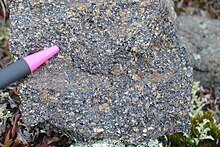
A vitrophyre is a porphyritic volcanic rock in which phenocrysts are embedded in a glassy matrix. Vitrophyres are contrasted from typical porphyritic rocks in that the latter has both crystalline phenocrysts (larger grains) and a crystalline matrix (smaller grains), whereas the former has a distinctly glassy matrix.[1] Vitrophyres can be alternatively described as rocks having vitrophyric texture.[2] This texture results from the rapid quenching of a lava where phenocrysts had started to form prior to eruption.[3]
See also
[edit]References
[edit]- ^ Best, Myron G. (2002). Igneous and Metamorphic Petrology. Blackwell Publishing. p. 27. ISBN 9781405105880.
- ^ Winter, John D. (2014). Principles of Igneous and Metamorphic Petrology. Pearson. p. 40. ISBN 9781292021539.
- ^ Philpotts, Anthony; Ague, Jay (2009). Principles of Igneous and Metamorphic Petrology. Cambridge University Press. p. 198. ISBN 9780521880060.
Well, that’s interesting to know that Psilotum nudum are known as whisk ferns. Psilotum nudum is the commoner species of the two. While the P. flaccidum is a rare species and is found in the tropical islands. Both the species are usually epiphytic in habit and grow upon tree ferns. These species may also be terrestrial and grow in humus or in the crevices of the rocks.
View the detailed Guide of Psilotum nudum: Detailed Study Of Psilotum Nudum (Whisk Fern), Classification, Anatomy, Reproduction